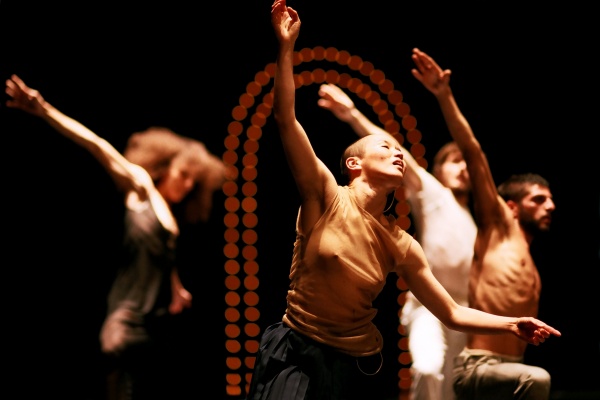Emio Greco/PC: “Hell” Is Other People, Dramatic Ones
Lightsey Darst watched Emio Greco/PC's "Hell" at the Walker's McGuire Theater. This troupe has been stirring a lot of excitement around the world; read on for more.

When Emio Greco/PC’s Hell was over, we were all a little dazed. The usual standing up, nodding, and shuffling began, everyone folding programs and tending exit-wards, but with blanker eyes and less sure feet. Someone said, “Well, I don’t know what to think about that,” and no one answered.
What had dazed us? The harsh changes of light, the volume at which Beethoven’s Fifth, electric guitars, and the rest of the score had been blasted? High volume can embrace and soothe, but so many sudden flares of sound left us flayed—a little hell spilling over. Were we dazed by the shifting of the scenario? Choreographer-Mephistopheles manipulated his dancer-humans, craving to be human, but he himself was manipulated by a shadowy masked figure, a figure who turns out in fact to be a harmless if voluptuous young woman. She, like matter in relation to antimatter, cannot execute her steps in the same direction as anyone else—and the choreographer-Mephistopheles tried to close the show by frantically turning off the light-bulbs, a false ending seeming to close the show, but then a figure striding forward from the audience (the audience—the ultimate devil?) started the dance again, spinning the light-bulbs back into their sockets—and I am making this all a little more coherent than it was on stage.
On stage what held was not story, but drama—and this too dazed us. A woman scuttling forward with her legs spread wide, each moment dropping farther into her crouch, finally clutching her own crotch—such vivid violation—and it went on into a perverse tango, a hiked-up leg draped over someone’s head. The strobe-lit solo for Greco, with his masked doppelganger flying around him in the shadows, each dancer seen in blurred snatches—such rich material does one in for the evening.
There was beauty too, dark beauty that struck at us—in the music, in the dancers’ nude limbs, in Greco/PC’s splintered ballet-dance. A series of entrechat quatres—scissoring but upright ballet jumps—kept their lovely symmetry, but the dancer’s loose arms conveyed desperation. Turned-out first position came across the dancers as a shock, an upright jerk. The swan queen’s shy pose was everywhere, one shielding arm up across the face. One movement was at once hideous and perfect: a slow foot-drag forward and back, the foot sickling on the way back, the whole thing looking like time turned in on itself. Before Hell quite began, Greco/PC’s dancers dazzled the audience with virtuoso disco; “Tell It to My Heart” was pure sublime, the dancer (Suzan Tunca) as pristine in her shimmy as a prima ballerina in her pirouette.
Perhaps it was the sheer weight of the physical that gave us all rabbit-eyes. Greco/PC relies on movement, not on acting or even on the drama of light and set. Watching Hell is like reading difficult poetry or physics—so many detailed paths overlie each other in time that the watcher becomes dizzy. The afterimage of one move competes with the present, but the present also captures the eye. Throughout the evening, Greco/PC never let up on the steps, the invention of strenuous motion, the breakneck use of the body.
Hell doesn’t arrive—it hovers, blurry; it oscillates. What is the hell of it? To imagine the dancers’ moves as struggles of the damned is dull. To trace the scenario of evil and control is unrewarding; dramaturgy is no strong point here. Was the hell to sit there and see and hear it, battered by the mass of it, unable to fix one’s relation to one moment before the next came along? There is pain in viewing strong work. We don’t know what to think of it, but we think of it. Inside us the pieces of it shift and burrow, sinking slowly into seeming dormancy. But they grow—and when we look back in we find thick-bodied spiders and thornless roses.